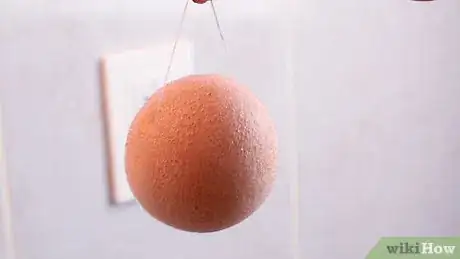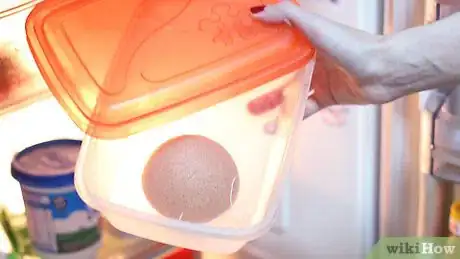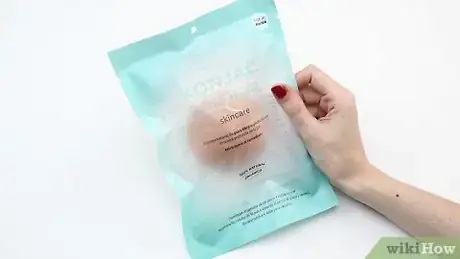This article was co-authored by wikiHow Staff. Our trained team of editors and researchers validate articles for accuracy and comprehensiveness. wikiHow's Content Management Team carefully monitors the work from our editorial staff to ensure that each article is backed by trusted research and meets our high quality standards.
The wikiHow Video Team also followed the article's instructions and verified that they work.
This article has been viewed 18,171 times.
Learn more...
Konjac sponges are one of the latest crazes in natural skincare, and for good reason. The sponges are made from a porous root vegetable of the same name, and are gentler than regular scrubbers. This makes them perfect for exfoliating, removing caked-on makeup, or simply scrubbing up. Using a Konjac sponge is as easy as soaking it in warm water, squeezing out the excess moisture, and lightly massaging your face or body.
Steps
Soaking the Sponge
-
1Remove the Konjac sponge from its airtight packaging. Konjac sponges are most often sold in sealed plastic bags. Packaging them this way helps to ensure that they’re not exposed to outside moisture prior to use. To open your new sponge, pull apart the plastic at one end of the bag. Check to make sure there are no visible defects or signs of damage.[1]
- Don’t use the sponge if the packaging it came in is already unsealed.
-
2Soak the sponge in warm water for 10-15 minutes. A preliminary soak is necessary to soften the hard, dry fibers prior to cleansing. As the sponge soaks, it will begin to grow in size. Once it stops expanding, it will be ready to use.
- Your Konjac sponge may need to soak for as long as 20 minutes to fully soften if it’s your first time using it.
- Look for your sponge to swell up to 1½ times its original size when wet.
Advertisement -
3Squeeze out the excess water. Remove the sponge from the water and press it firmly between the palms of your hands. For best results, it should be nice and moist, but not sopping wet.[2]
- Try not to be too rough with your Konjac sponge. Wringing, twisting, or stretching it could damage the natural plant fibers.
Cleaning Your Skin
-
1Dampen your skin with warm water. The warmth of the water will help open up your pores, making the sponge more effective at clearing away dirt, debris, and oil. For this reason, it can be especially convenient to use your Konjac sponge during or just after a hot shower.[3]
- Konjac sponges are delicate enough to use for both facial and full-body cleansing.[4]
-
2Massage your skin using a gentle circular motion. Start at the center of the desired area and radiate outward, making the circle larger with each pass. The tiny pores on the surface of the sponge will work together to clean and exfoliate, so there’s no need to press down too hard.
- You should be able to feel a noticeable difference in your skin immediately after use.[5]
- Avoid scrubbing forcefully around your eyes, and on sensitive areas like acne spots or dry, irritated patches of skin.
-
3Add a few drops of your favorite cleanser for a deeper clean. If you like, you can squeeze a small amount of soap, moisturizer, or exfoliating face wash directly onto the sponge and work it in until it forms a rich lather. Konjac is super absorbent, so it will hold and disperse skincare products as well as any regular sponge to give your skin that freshly-cleaned feeling.[6]
- Due to its small size, the sponge may lose most of its lather after a few minutes of continuous scrubbing. You may need to add more cleanser if you’re going over larger areas, like your chest, back, or legs.
- Talk to your dermatologist before using a Konjac sponge to apply retinoids or other medicated products.
-
4Use your Konjac sponge as a makeup remover. With just a dab of penetrating cleanser, a Konjac sponge can easily wipe away leftover foundation, blush, or eyeshadow. Just be sure there’s no makeup left behind on the sponge once your face is bare.
- It may be necessary to use a traditional makeup remover to weaken the hold of cosmetics with more staying power, like mascara and lip and eyeliner.
Caring for Your Konjac Sponge
-
1Rinse your Konjac sponge thoroughly after each use. Hold the sponge under a stream of warm running water and squeeze it repeatedly to flush out dirt, oil, and traces of cleanser. Continue rinsing and squeezing until the water runs clear. Then, press out any remaining moisture by hand.
- Avoid washing your Konjac sponge with boiling water. High temperatures could lead to shrinking or damage.
- Leaving your sponge saturated with water or skincare products will make it a breeding ground for mold and bacteria.
-
2Hang your Konjac sponge in a well-ventilated area to dry between uses. When stored properly, any lingering moisture should evaporate overnight. Your sponge will then re-harden and be ready for the next soak.[7]
- Because of the high amount of humidity in the air, the bathroom where you take your daily shower may not be the best place to keep your Konjac sponge.
-
3Store your sponge in an airtight container in the refrigerator. If you don’t have a suitable place to hang up your used sponge, stick it in a lidded Tupperware container or plastic bag and stash it in the fridge. The cool, dry air will slow the growth of mold and bacteria in the spaces inside the tightly-knit fibers.
- It’s normal for the sponge to still be a little damp when you first take it out of the refrigerator.
- Keeping your Konjac sponge in the refrigerator as opposed to hanging it up may cause it to wear out faster.
-
4Replace your Konjac sponge every 4-6 weeks. After a while, your sponge will lose its original texture and begin to disintegrate. When this happens, it’s time to pick up a new one. Getting in the habit of switching out your sponges as soon as they begin to deteriorate will ensure that your skin stays clear, healthy, and radiant.
- Your Konjac sponge may enjoy a longer lifespan if you don’t use it every single day.
- When it comes time to dispose of your sponge, you could simply toss it in the trash, or you could add it to a potted plant or compost heap. That’s how natural it is![8]
Warnings
- While Konjac sponges are useful for cleaning, softening, and reinvigorating skin, they’re not effective for treating persistent skin conditions like acne and eczema.⧼thumbs_response⧽
Things You'll Need
- Konjac sponge
- Warm water
- Facial cleanser
- Airtight container or plastic zipper bag (for refrigerator storage)
References
- ↑ https://www.youtube.com/watch?v=h6HXOHyk3Ew&feature=youtu.be&t=23
- ↑ https://www.allure.com/story/how-to-use-konjac-sponges
- ↑ https://www.youtube.com/watch?v=h6HXOHyk3Ew&feature=youtu.be&t=53
- ↑ https://www.allure.com/story/how-to-use-konjac-sponges
- ↑ https://www.allure.com/story/how-to-use-konjac-sponges
- ↑ https://www.refinery29.com/2014/01/59896/konjac-sponge
- ↑ https://www.refinery29.com/2014/01/59896/konjac-sponge
- ↑ https://www.allure.com/story/how-to-use-konjac-sponges









-Step-12-Version-3.webp)



















































